Page 172 of 267
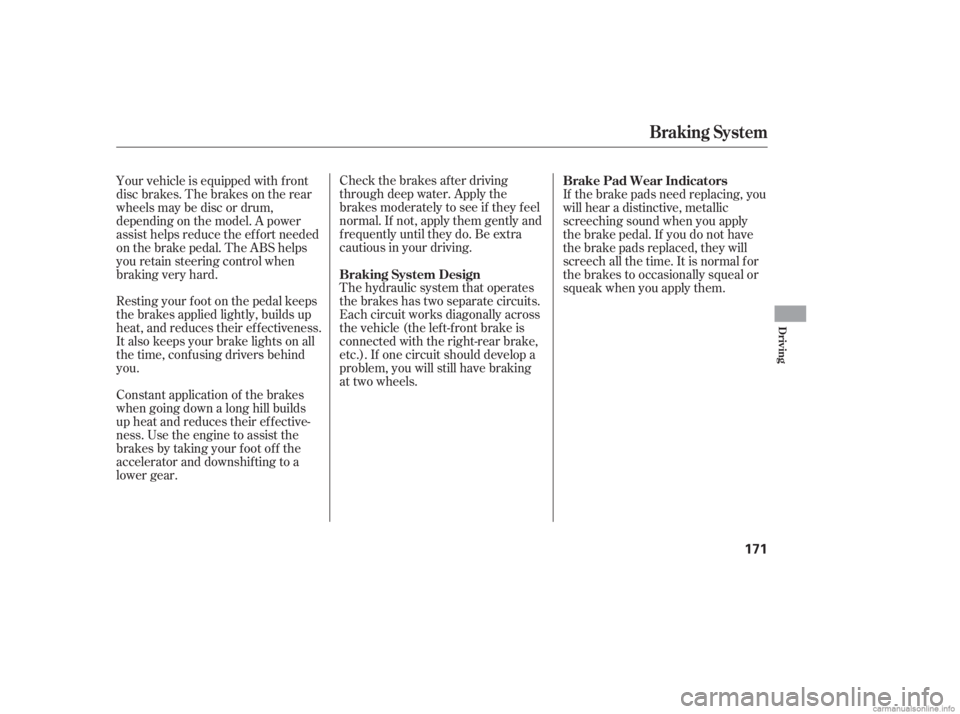
Check the brakes after driving
through deep water. Apply the
brakes moderately to see if they f eel
normal. If not, apply them gently and
f requently until they do. Be extra
cautious in your driving.
Resting your f oot on the pedal keeps
the brakes applied lightly, builds up
heat, and reduces their ef f ectiveness.
It also keeps your brake lights on all
the time, conf using drivers behind
you.
Constant application of the brakes
when going down a long hill builds
up heat and reduces their ef f ective-
ness. Use the engine to assist the
brakes by taking your f oot of f the
accelerator and downshif ting to a
lower gear. The hydraulic system that operates
the brakes has two separate circuits.
Each circuit works diagonally across
the vehicle (the lef t-f ront brake is
connected with the right-rear brake,
etc.). If one circuit should develop a
problem, you will still have braking
at two wheels.If the brake pads need replacing, you
will hear a distinctive, metallic
screeching sound when you apply
the brake pedal. If you do not have
the brake pads replaced, they will
screech all the time. It is normal f or
the brakes to occasionally squeal or
squeak when you apply them.
Your vehicle is equipped with f ront
disc brakes. The brakes on the rear
wheels may be disc or drum,
depending on the model. A power
assist helps reduce the ef f ort needed
on the brake pedal. The ABS helps
you retain steering control when
braking very hard.
Braking System DesignBrake Pad Wear Indicators
Braking System
Driving
171
�����—�����—�����y�
�������������y���
�(�#���������y���
�����y
Page 173 of 267
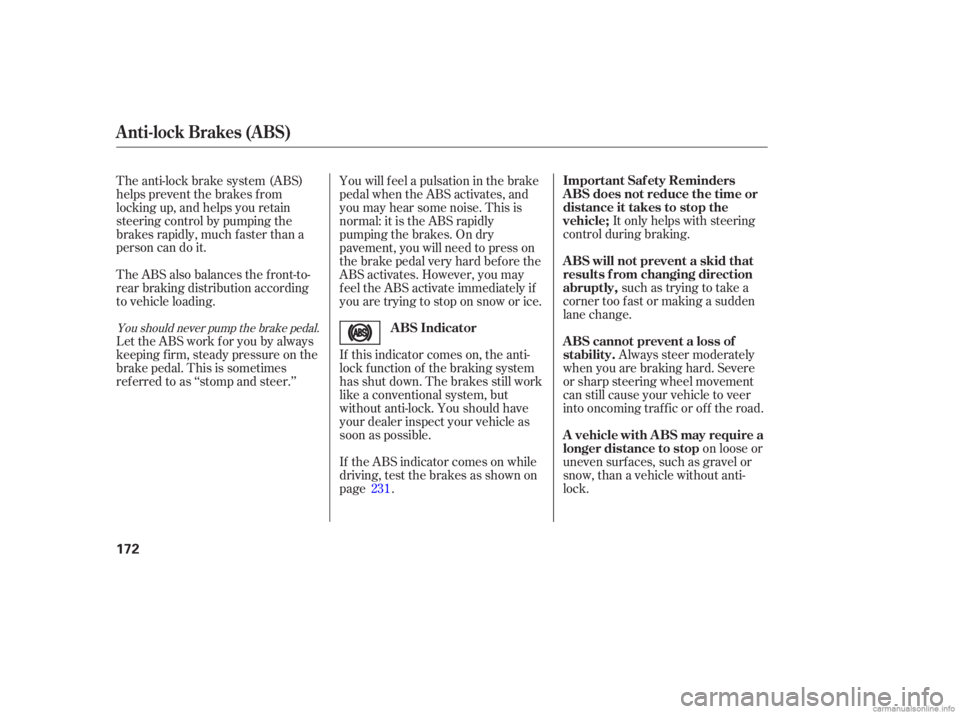
such as trying to take a
corner too f ast or making a sudden
lane change.
Always steer moderately
when you are braking hard. Severe
or sharp steering wheel movement
can still cause your vehicle to veer
into oncoming traffic or off the road. It only helps with steering
control during braking.
on loose or
uneven surf aces, such as gravel or
snow, than a vehicle without anti-
lock.
The anti-lock brake system (ABS)
helps prevent the brakes f rom
locking up, and helps you retain
steering control by pumping the
brakes rapidly, much f aster than a
person can do it.
You will f eel a pulsation in the brake
pedal when the ABS activates, and
you may hear some noise. This is
normal: it is the ABS rapidly
pumpingthebrakes.Ondry
pavement, you will need to press on
thebrakepedalveryhardbeforethe
ABS activates. However, you may
feel the ABS activate immediately if
you are trying to stop on snow or ice.
The ABS also balances the f ront-to-
rear braking distribution according
to vehicle loading.
Let the ABS work f or you by always
keeping f irm, steady pressure on the
brake pedal. This is sometimes
ref erred to as ‘‘stomp and steer.’’
If the ABS indicator comes on while
driving, test the brakes as shown on
page . If this indicator comes on, the anti-
lock f unction of the braking system
has shut down. The brakes still work
like a conventional system, but
without anti-lock. You should have
your dealer inspect your vehicle as
soon as possible.231
You should never pump the brake pedal.
Important Saf ety Reminders
A BS will not prevent a skid that
results f rom changing direction
abruptly,
A BS cannot prevent a loss of
stability. A BS does not reduce the time or
distance it takes to stop the
vehicle;
A vehicle with A BS may require a
longer distance to stop
ABS Indicator
Anti-lock Brakes (ABS)
172
�����—�����—�����y�
���������
���y���
�(�#���������y���
�����y
Page 178 of 267
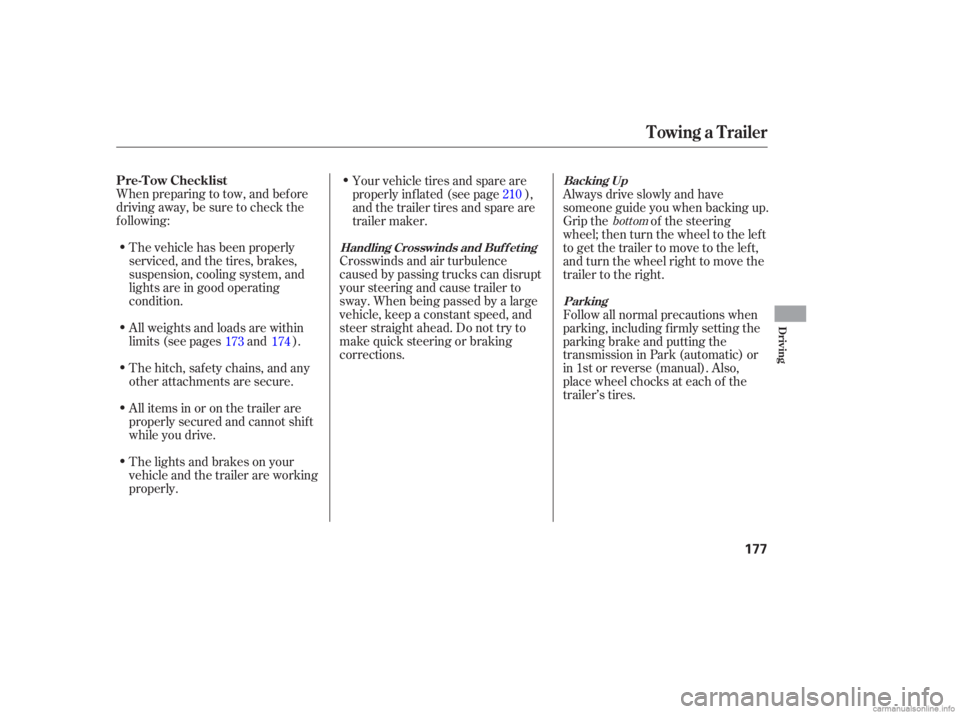
When preparing to tow, and bef ore
driving away, be sure to check the
f ollowing:The vehicle has been properly
serviced, and the tires, brakes,
suspension, cooling system, and
lights are in good operating
condition.
All weights and loads are within
limits (see pages and ).
Thehitch,safetychains,andany
other attachments are secure.
All items in or on the trailer are
properly secured and cannot shif t
while you drive.
The lights and brakes on your
vehicle and the trailer are working
properly. Your vehicle tires and spare are
properly inf lated (see page ),
and the trailer tires and spare are
trailer maker.
Crosswinds and air turbulence
caused by passing trucks can disrupt
your steering and cause trailer to
sway. When being passed by a large
vehicle, keep a constant speed, and
steer straight ahead. Do not try to
make quick steering or braking
corrections. Always drive slowly and have
someone guide you when backing up.
Grip the of the steering
wheel; then turn the wheel to the lef t
to get the trailer to move to the lef t,
andturnthewheelrighttomovethe
trailer to the right.
Follow all normal precautions when
parking, including f irmly setting the
parking brake and putting the
transmission in Park (automatic) or
in 1st or reverse (manual). Also,
place wheel chocks at each of the
trailer’s tires.
173 174 210
bottom
Towing a Trailer
Pre-T ow Checklist
Handling Crosswinds and Buf f et ing
Backing Up
Parking
Driving
177
�����—�����—�����y�
�������������y���
�(�#���������y���
�����y
Page 200 of 267
Always use Honda Power Steering
Fluid. You may use another power
steering f luid as an emergency
replacement, but have the power
steering system f lushed and ref illed
with Honda PSF as soon as possible.
A low power steering f luid level can
indicate a leak in the system. Check
the f luid level f requently, and have
the system inspected as soon as
possible.
Check the level on the side of the
reservoir when the engine is cold.
The f luid should be between the
UPPER LEVEL and LOWER LEVEL.
If not add power steering f luid to the
UPPER LEVEL mark.
Pour the f luid slowly and caref ully so
you do not spill any. Clean up any
spill immediately; it could damage
components in the engine
compartment.
Power Steering Fluid
Maint enance
199
UPPER LEVEL
LOWER LEVEL
Turning the steering wheel to f ull lef t
or right lock and holding it there can
damage the power steering pump.
�����—�����—�����y�
�����������
�y���
�(�#���������y���������y
Page 202 of 267
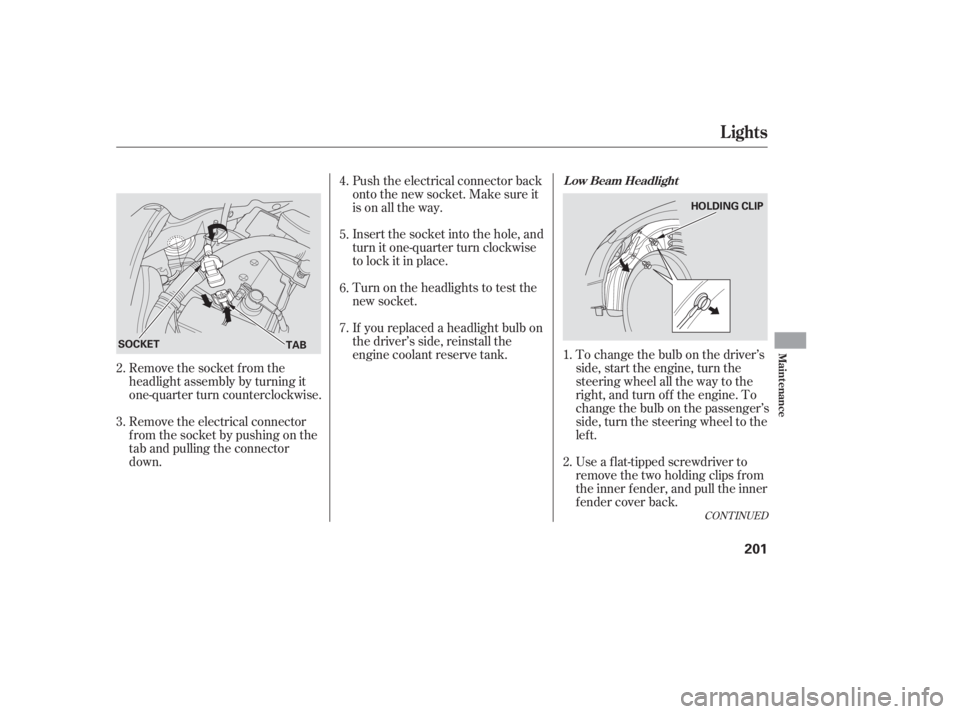
If youreplacedaheadlightbulbon
the driver’s side, reinstall the
engine coolant reserve tank.
Remove the socket from the
headlight assembly by turning it
one-quarter turn counterclockwise.
Remove the electrical connector
f rom the socket by pushing on the
tab and pulling the connector
down. Insert the socket into the hole, and
turn it one-quarter turn clockwise
to lock it in place. Push the electrical connector back
ontothenewsocket.Makesureit
is on all the way.
Turn on the headlights to test the
new socket.
To change the bulb on the driver’s
side, start the engine, turn the
steering wheel all the way to the
right, and turn of f the engine. To
change the bulb on the passenger’s
side, turn the steering wheel to the
lef t.
Use a f lat-tipped screwdriver to
remove the two holding clips f rom
the inner f ender, and pull the inner
f ender cover back.
2.
3.
2.
4.
5.
6.
7.
1.
CONT INUED
Lights
L ow Beam Headlight
Maint enance
201
TAB HOLDING CLIP
SOCKET
�����—�����—�����y�
�������������y���
�(�#���������y���������y
Page 203 of 267
To change the bulb on the driver’s
side, start the engine, turn the
steering wheel all the way to the
right, and turn of f the engine. To
change the bulb on the passenger’s
side, turn the steering wheel to the
lef t.
Reinstall the inner f ender cover.
Then reinstall the holding clips,
andlocktheminplacebypushing
on their centers.
Remove the socket from the
headlight assembly by turning it
one-quarter turn counterclockwise.
Remove the electrical connector
f rom the socket by pushing on the
tab and pulling the connector
down. Push the electrical connector back
ontothenewsocket.Makesureit
is on all the way.
Turn on the headlights to test the
new socket. Insert the new socket into the hole,
and turn it one-quarter turn
clockwise to lock it in place.
5.
6.
1.
7.
8.
3.
4.
Lights
Replacing the Front Side Marker/
Parking/Turn Signal Light Bulb
202
TAB HOLDING CLIP
SOCKET
�����—�����—�����y�
�������������y���
�(�#���������y���������y
Page 212 of 267
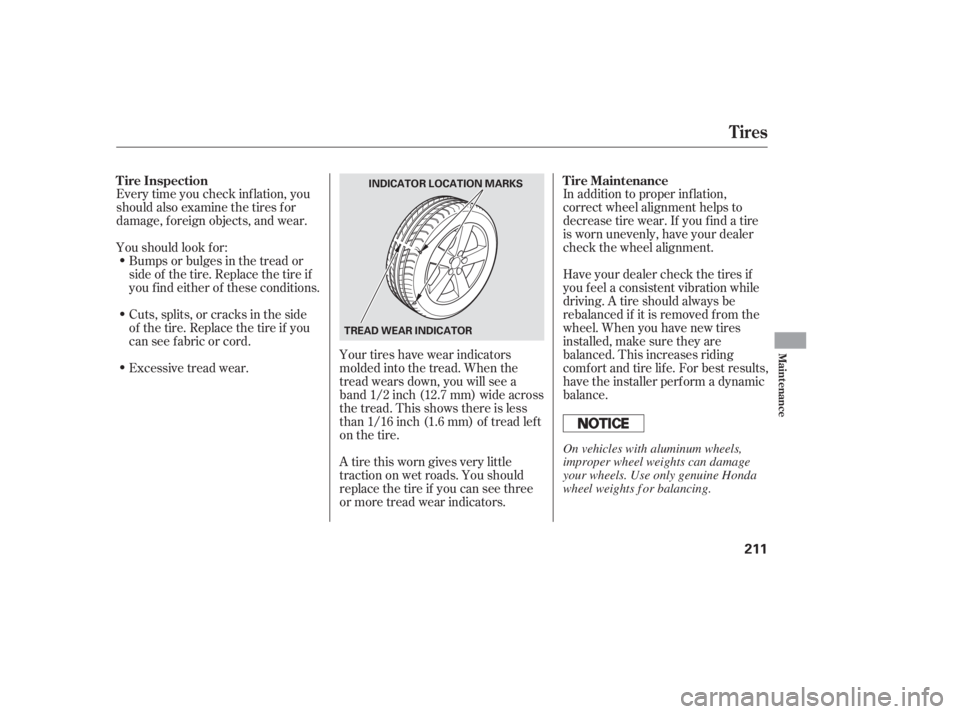
Every time you check inf lation, you
should also examine the tires f or
damage, f oreign objects, and wear.
Youshouldlookfor:Bumps or bulges in the tread or
side of the tire. Replace the tire if
youfindeitherof theseconditions.
Cuts, splits, or cracks in the side
of the tire. Replace the tire if you
can see f abric or cord.
Excessive tread wear. In addition to proper inf lation,
correct wheel alignment helps to
decrease tire wear. If you f ind a tire
is worn unevenly, have your dealer
check the wheel alignment.
Have your dealer check the tires if
you f eel a consistent vibration while
driving. A tire should always be
rebalanced if it is removed f rom the
wheel. When you have new tires
installed, make sure they are
balanced. This increases riding
comf ort and tire lif e. For best results,
have the installer perform a dynamic
balance.
Your tires have wear indicators
molded into the tread. When the
tread wears down, you will see a
band 1/2 inch (12.7 mm) wide across
the tread. This shows there is less
than 1/16 inch (1.6 mm) of tread lef t
on the tire.
A tire this worn gives very little
traction on wet roads. You should
replace the tire if you can see three
or more tread wear indicators.
Tire Inspection Tire Maintenance
Tires
Maint enance
211
TREAD WEAR INDICATOR
INDICATOR LOCATION MARKS
On vehicles with aluminum wheels,
improper wheel weights can damage
your wheels. Use only genuine Honda
wheel weights f or balancing.
�����—�����—�����y�
�������������y���
�(�#���������y�����
���y
Page 213 of 267
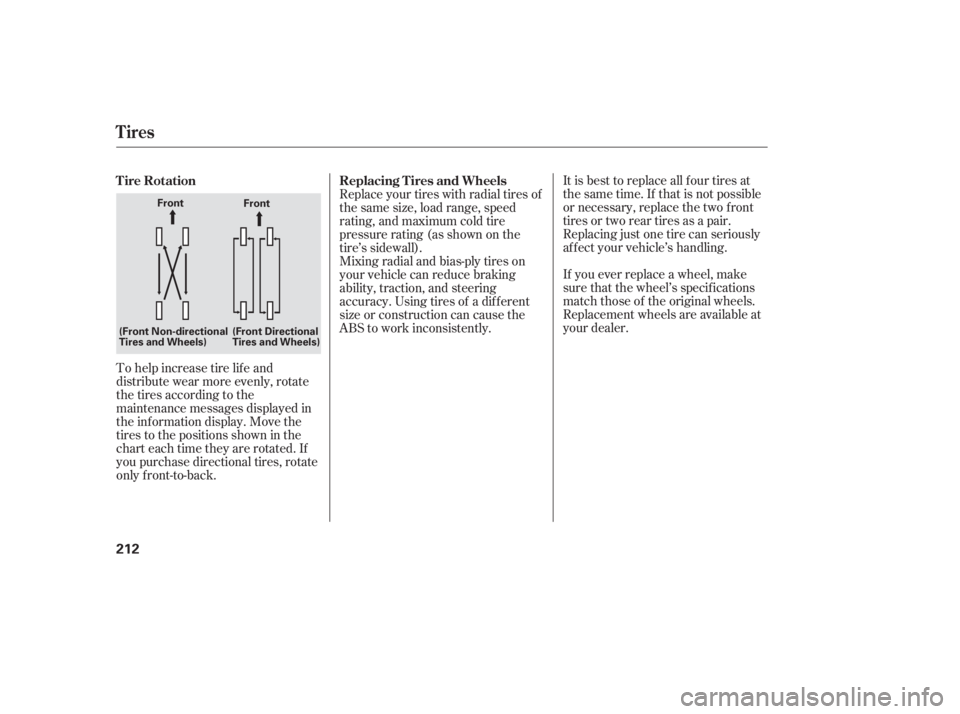
It is best to replace all f our tires at
thesametime.If thatisnotpossible
or necessary, replace the two f ront
tires or two rear tires as a pair.
Replacing just one tire can seriously
af f ect your vehicle’s handling.
If you ever replace a wheel, make
sure that the wheel’s specif ications
match those of the original wheels.
Replacement wheels are available at
your dealer.
To help increase tire lif e and
distribute wear more evenly, rotate
the tires according to the
maintenance messages displayed in
the information display. Move the
tires to the positions shown in the
chart each time they are rotated. If
you purchase directional tires, rotate
only f ront-to-back. Replace your tires with radial tires of
the same size, load range, speed
rating, and maximum cold tire
pressure rating (as shown on the
tire’s sidewall).
Mixing radial and bias-ply tires on
your vehicle can reduce braking
ability, traction, and steering
accuracy. Using tires of a dif f erent
size or construction can cause the
ABS to work inconsistently.
T ire Rotation Replacing T ires and Wheels
Tires
212
Front
Front
(Front Directional
Tires and Wheels)
(Front Non-directional
Tires and Wheels)
�����—�����—�����y�
������
������y���
�(�#���������y�����
���y